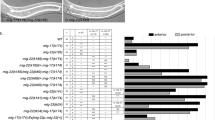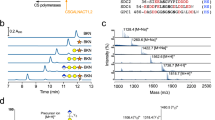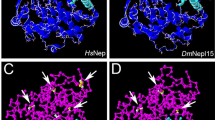Abstract
Glycosaminoglycans such as heparan sulphate and chondroitin sulphate are extracellular sugar chains involved in intercellular signalling. Disruptions of genes encoding enzymes that mediate glycosaminoglycan biosynthesis have severe consequences in Drosophila and mice1,2,3,4,5. Mutations in the Drosophila gene sugarless, which encodes a UDP-glucose dehydrogenase, impairs developmental signalling through the Wnt family member Wingless, and signalling by the fibroblast growth factor and Hedgehog pathways. Heparan sulphate is involved in these pathways6,7,8, but little is known about the involvement of chondroitin. Undersulphated and oversulphated chondroitin sulphate chains have been implicated in other biological processes, however, including adhesion of erythrocytes infected with malaria parasite to human placenta and regulation of neural development9,10. To investigate chondroitin functions, we cloned a chondroitin synthase homologue of Caenorhabditis elegans and depleted expression of its product by RNA-mediated interference and deletion mutagenesis. Here we report that blocking chondroitin synthesis results in cytokinesis defects in early embryogenesis. Reversion of cytokinesis is often observed in chondroitin-depleted embryos, and cell division eventually stops, resulting in early embryonic death. Our findings show that chondroitin is required for embryonic cytokinesis and cell division.
This is a preview of subscription content, access via your institution
Access options
Subscribe to this journal
Receive 51 print issues and online access
$199.00 per year
only $3.90 per issue
Buy this article
- Purchase on Springer Link
- Instant access to full article PDF
Prices may be subject to local taxes which are calculated during checkout




Similar content being viewed by others
References
Forsberg, E. & Kjellén, L. Heparan sulfate: lessons from knockout mice. J. Clin. Invest. 108, 175–180 (2001)
Iozzo, R. V. Heparan sulfate proteoglycans: intricate molecules with intriguing functions. J. Clin. Invest. 108, 165–167 (2001)
Lander, A. D. & Selleck, S. B. The elusive functions of proteoglycans: in vivo veritas. J. Cell Biol. 148, 227–232 (2000)
Perrimon, N. & Bernfield, M. Specificities of heparan sulphate proteoglycans in developmental processes. Nature 404, 725–728 (2000)
Sugahara, K. & Kitagawa, H. Recent advances in the study of the biosynthesis and functions of sulfated glycosaminoglycans. Curr. Opin. Struct. Biol. 10, 518–527 (2000)
Hacker, U., Lin, X. & Perrimon, N. The Drosophila sugarless gene modulates Wingless signaling and encodes an enzyme involved in polysaccharide biosynthesis. Development 124, 3565–3573 (1997)
Lin, X., Buff, E. M. & Perrimon, N. Heparan sulfate proteoglycans are essential for FGF receptor signaling during Drosophila embryonic development. Development 126, 3715–3723 (1999)
Tsuda, M. et al. The cell-surface proteoglycan Dally regulates Wingless signalling in Drosophila. Nature 400, 276–280 (1999)
Bradbury, E. J. et al. Chondroitinase ABC promotes functional recovery after spinal cord injury. Nature 416, 636–640 (2002)
Sugahara, K. & Yamada, S. Structure and function of oversulfated chondroitin sulfate variants: unique sulfation patterns and neuroregulatory activities. Trends Glycosci. Glycotechnol. 12, 321–349 (2000)
Uyama, T., Kitagawa, H., Tamura, J. & Sugahara, K. Molecular cloning and expression of human chondroitin N-acetylgalactosaminyltransferase: the key enzyme for chain initiation and elongation of chondroitin/dermatan sulfate on the protein linkage region tetrasaccharide shared by heparin/heparan sulfate. J. Biol. Chem. 277, 8841–8846 (2002)
Uyama, T. et al. Molecular cloning and expression of a second chondroitin N-acetylgalactosaminyltransferase involved in the biosynthetic initiation and elongation of chondroitin/dermatan sulfate. J. Biol. Chem. 278, 3072–3078 (2003)
Kitagawa, H., Uyama, T. & Sugahara, K. Molecular cloning and expression of a human chondroitin synthase. J. Biol. Chem. 276, 38721–38726 (2001)
Toyoda, H., Kinoshita-Toyoda, A. & Selleck, S. B. Structural analysis of glycosaminoglycans in Drosophila and Caenorhabditis elegans and demonstration that tout-velu, a Drosophila gene related to EXT tumour suppressors, affects heparan sulfate in vivo. J. Biol. Chem. 275, 2269–2275 (2000)
Yamada, S. et al. Demonstration of glycosaminoglycans in Caenorhabditis elegans. FEBS Lett. 459, 327–331 (1999)
Bateman, A. et al. The Pfam protein families database. Nucleic Acids Res. 30, 276–280 (2002)
Maeda, I., Kohara, Y., Yamamoto, M. & Sugimoto, A. Large-scale analysis of gene function in Caenorhabditis elegans by high-throughput RNAi. Curr. Biol. 11, 171–176 (2001)
Kamath, R. S., Martinez-Campos, M., Zipperlen, P., Fraser, A. G. & Ahringer, J. Effectiveness of specific RNA-mediated interference through ingested double-stranded RNA in Caenorhabditis elegans. Genome Biol. 2 research0002.1–0002.10 [online] 〈http://genomebiology.com/2000/2/1/research/0002〉 (2001)
Timmons, L., Court, D. L. & Fire, A. Ingestion of bacterially expressed dsRNAs can produce specific and potent genetic interference in Caenorhabditis elegans. Gene 263, 103–112 (2001)
Reddien, P. W. & Horvitz, H. R. CED-2/CrkII and CED-10/Rac control phagocytosis and cell migration in Caenorhabditis elegans. Nature Cell Biol. 2, 131–136 (2000)
Gengyo-Ando, K. & Mitani, S. Characterization of mutations induced by ethyl methanesulfonate, UV, and trimethylpsoralen in the nematode Caenorhabditis elegans. Biochem. Biophys. Res. Commun. 269, 64–69 (2000)
Kitagawa, H. et al. rib-2, a Caenorhabditis elegans homolog of the human tumour suppressor EXT genes encodes a novel α1,4-N-acetylglucosaminyltransferase involved in the biosynthetic initiation and elongation of heparan sulfate. J. Biol. Chem. 276, 4834–4838 (2001)
Lindahl, U. & Rodén, L. in Glycoproteins (ed. Gottschalk, A.) 491–517 (Elsevier, New York, 1972)
Bulik, D. A. et al. sqv-3, -7, and -8, a set of genes affecting morphogenesis in Caenorhabditis elegans, encode enzymes required for glycosaminoglycan biosynthesis. Proc. Natl Acad. Sci. USA 97, 10838–10843 (2000)
Herman, T., Hartwieg, E. & Horvitz, H. R. sqv mutants of Caenorhabditis elegans are defective in vulval epithelial invagination. Proc. Natl Acad. Sci. USA 96, 968–973 (1999)
Kitagawa, H. et al. Molecular cloning and expression of glucuronyltransferase I involved in the biosynthesis of the glycosaminoglycan-protein linkage region of proteoglycans. J. Biol. Chem. 273, 6615–6618 (1998)
Christensen, M. & Strange, K. Developmental regulation of a novel outwardly rectifying mechanosensitive anion channel in Caenorhabditis elegans. J. Biol. Chem. 276, 45024–45030 (2001)
Kamath, R. S. et al. Systematic functional analysis of the Caenorhabditis elegans genome using RNAi. Nature 421, 231–237 (2003)
Brecht, M., Mayer, U., Schlosser, E. & Prehm, P. Increased hyaluronate synthesis is required for fibroblast detachment and mitosis. Biochem. J. 239, 445–450 (1986)
Miller, D. M. & Shakes, D. C. Caenorhabditis elegans. in Modern Biological Analysis of an Organism (eds Epstein, H. F. & Shakes, D. C.) 365–394 (Academic, London, 1995)
Acknowledgements
We thank T. Stiernagle and the Caenorhabditis Genetics Center for all worms and E. coli strains, and Y. Kohara for the yk clones. K.N. was supported by PRESTO and SORST of the Japan Science and Technology Corporation (JST). S.M. and K.H.N. were supported partly by Sasakawa Scientific Research Grant (JSS). The work at Kobe Pharmaceutical University was supported in part by a Science Research Promotion Fund from the Japan Private School Promotion Foundation, and by Grants-in-Aid for Scientific Research C (to H.K.) and Scientific Research B (to K.S.) from the Ministry of Education, Science, Sports and Culture of Japan.
Author information
Authors and Affiliations
Corresponding authors
Ethics declarations
Competing interests
The authors declare that they have no competing financial interests.
Supplementary information
Rights and permissions
About this article
Cite this article
Mizuguchi, S., Uyama, T., Kitagawa, H. et al. Chondroitin proteoglycans are involved in cell division of Caenorhabditis elegans. Nature 423, 443–448 (2003). https://doi.org/10.1038/nature01635
Received:
Accepted:
Issue Date:
DOI: https://doi.org/10.1038/nature01635
This article is cited by
-
The hydrophobic cluster on the surface of protein is the key structural basis for the SDS-resistance of chondroitinase VhChlABC
Marine Life Science & Technology (2023)
-
Assembling custom side chains on proteoglycans to interrogate their function in living cells
Nature Communications (2020)
-
Molecular similarities and differences from human pulmonary fibrosis and corresponding mouse model: MALDI imaging mass spectrometry in comparative medicine
Laboratory Investigation (2018)
-
Molecular mechanisms of contractile-ring constriction and membrane trafficking in cytokinesis
Biophysical Reviews (2018)
-
Nematodes join the family of chondroitin sulfate-synthesizing organisms: Identification of an active chondroitin sulfotransferase in Caenorhabditis elegans
Scientific Reports (2016)
Comments
By submitting a comment you agree to abide by our Terms and Community Guidelines. If you find something abusive or that does not comply with our terms or guidelines please flag it as inappropriate.



